
5 things we’ve learnt about play in Aotearoa (so far)
blog | 13 Aug 2021
Play is a vital part of children’s physical and cognitive development, helping them build the skills and attitudes they need to be active for life. Sport New Zealand Ihi Aotearoa is committed to increasing opportunities for children to access quality play experiences, and over the past 18 months we’ve been working with an early group of Regional Sports Trusts across the motu to learn about what play looks like in Aotearoa today, how it has changed over time, and what helps – or gets in the way of – play.
To do this, we’ve held hui in Ōtautahi Christchurch, Invercargill, Tairāwhiti (all three of which also double as Healthy Families sites) and Whanganui to hear from people who have an influence on play opportunities or spaces in their region, including those in education and sport/recreation, spatial designers, local and central government staff, disability advocates, and mana whenua. We’ve also talked with whānau and tamariki to hear about what play looks like for them and their hopes for the future of play in their region.
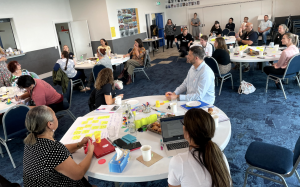
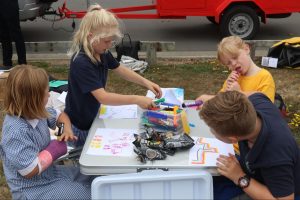
Images of hui with stakeholders in Gisborne and tamariki in Ōtautahi Christchurch, and top drawing from Whanganui tamariki.
5 emerging themes and opportunities from four regions:
- Every region has its own unique play flavour
The four regions share a deep pride of place and easy access to natural play spaces. However, each region also has unique cultural and geographic features which shape the opportunities available and community mindsets around play. In Ōtautahi Christchurch, recovery from the 2011 earthquake has created a strong focus on working together for the wellbeing of the community, and empty spaces have been re-framed as opportunities to bring fresh and playful thinking to the city. Invercargill is a highly connected community with relationships that span across generations. Southlanders are proud to be ‘born and bred’ in the South, and have a culture of mucking in and helping each other out. Whanganui has a strong creative culture and connection to te Awa, and Tairāwhiti is steeped in te ao Māori where play activities have historically centred around survival in te taiao – such as hunting, fishing and collecting kai.
“We are ocean, waterpeople.” – East Coast stakeholder
Opportunity: How might we celebrate our local stories and unique ways of playing across Aotearoa?

Image of whānau playing in Tairāwhiti, by Sport Gisborne Tairāwhiti.
- Increased fears and regulations around safety can make it difficult for children to learn and grow
An increased focus on safety and the resulting restrictions on play activities has been raised across all four regions. People spoke about how this is leaving less room for children to develop fundamental skills and confidence through risk-taking. Teachers shared how difficult it has become to create opportunities for children both within and outside the school environment to try, make mistakes, and learn when there are so many rules, regulations, and paperwork required to do so. This frustration was shared by council staff who spoke about how Health and Safety rules, Code of Compliance, and other consent processes can get in the way of new ideas for play. Interestingly, some stakeholders believed that modern parents don’t let their children take risks due to fear of their child getting hurt. However, some parents told us that what they really fear is judgment from other adults if their child is injured. Some parents wanted to let their children take risks and roam further from home on their own, but they were unsure of what is appropriate at what age.
“There’s a big difference between a ‘learning injury’ – little bumps or bruises – versus a life-changing injury. I just wish there was more awareness of that in the whole community…” – Invercargill parent
Opportunity: How might we create a healthier balance between learning risks and child safety?
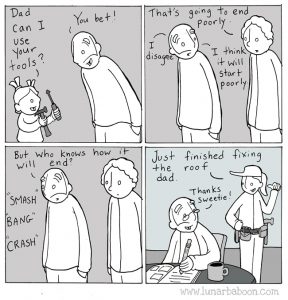
Comic about risk-taking mentioned by one Gisborne parent. Source: http://www.lunarbaboon.com/comics/tools.html
- Children, parents, and stakeholders have slightly different views about the role of technology in play
The influence of information and technology on how tamariki play today has been a popular topic across all four regions. While stakeholders tended to see it mostly as a barrier that had replaced outdoor or active play, parents often perceived digital devices and digital play as more of a double-edged sword where finding balance was important. On one hand they saw that it could get in the way of play if children spent too much time passively consuming content, but they also saw that it could enable connection, creativity, learning, relaxation, and provide valuable time for parents to get other things done. Tamariki mostly saw the use of digital devices as just another play activity, and didn’t draw a line between digital and non-digital play.
“Play isn’t the same because of technology, because Te Puni Kōkiri has put wifi on the marae. How do you keep kids off tech at marae, off the wifi?” – Whanganui stakeholder
Opportunity: How might we leverage technology in our community to enhance – not hinder – play experiences?
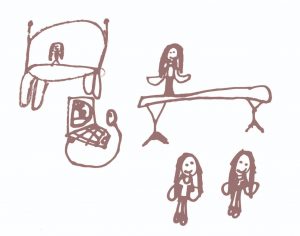
Drawing from tamaiti in Whanganui about their favourite ways to play, including on the laptop.
- Access to play spaces and opportunities is not equal
In each region, inequitable access to play spaces and opportunities has been raised, in particular for those who live in lower socio-economic or rural areas, or those who have a disability. Christchurch stakeholders discussed how limited, costly, unsafe, and time-consuming travel options as well as the growing financial divide between families can prevent tamariki in rural areas from accessing different play spaces.. In Invercargill there was a distinct divide between the Northern and Southern suburbs, with play spaces and activities often being provided in more privileged areas. Similar concerns were raised in Whanganui, and in Tairāwhiti a lack of safe local play facilities in rural communities can mean that some tamariki miss out.
“My parents always have to drive me to playgrounds in other parts of Gisborne. We have nothing here.” – Tamaiti
After identifying a lack of accessible play spaces for people with disabilities, Whanganui District Council and Sport Whanganui are working together to address these barriers. Spaces that were seen as ‘more accessible’ still had very limited facilities and while there are some opportunities for young people with disabilities to participate, this is often limited in school and club environments. Stakeholders from most regions also talked about how play should be for everyone, at any age – and that play spaces should cater to the whole whānau to enable intergenerational play.
Opportunity: How might we create public play spaces and opportunities that everyone can enjoy?
- Built and natural environments have a strong influence on when tamariki can play
In all four regions, the natural environment – mountains, forrests, rivers, and oceans – have been seen as strong enablers for play and community wellbeing. However, when these places are not cared for or there is limited access to them, the community can also suffer. In contrast, the modern built environment was seldom seen as an enabler of play outside of specific play spaces such as playgrounds and sports facilities. Many parents spoke about how the abundance of cars means there is less space for play today compared to their childhoods, and how fast drivers can make them hesitant to let their children roam or ride their bikes.
“Town is a lot busier now – there’s so much more traffic, and less patience for cyclists. It’s not safe for kids on their bikes, and I worry about my son going somewhere by himself.” – Whanganui parent
Opportunities: How might we prioritise play in our regional planning, strategy and policies? And how might we exercise kaitiakitanga of te taiao (guardianship of the natural world) so that generations to come can play?
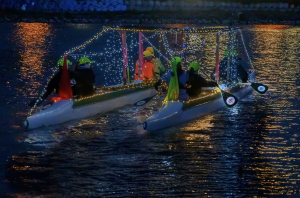
Photo of creative event in Whanganui by Jacqui McGowan.
The findings from this mahi are already starting to inform local action and national strategies, and we will continue to share what we learn from additional regions. In the meantime, we encourage you to use the opportunities to start a conversation about what the future of play could look like in your region, neighbourhood, and whānau.
For more information about this kaupapa, please get in touch with Emily Preston: emily.preston@innovationunit.org